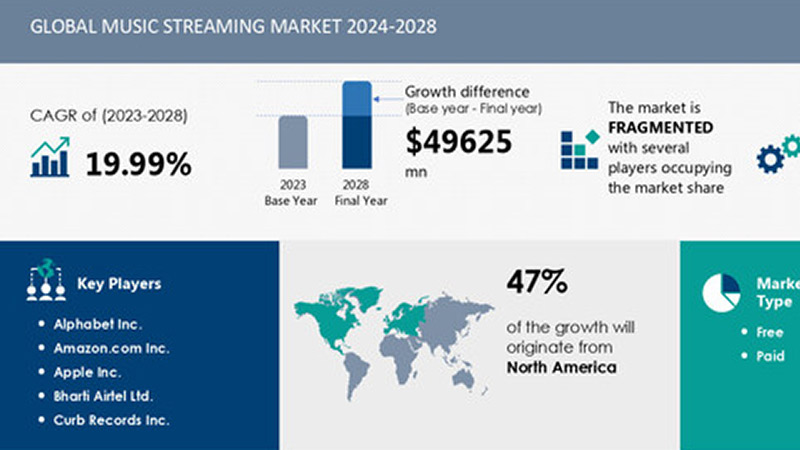
Music Streaming Market to Grow by $49.63 Billion (2024-2028)
The global music streaming market size is estimated to grow by USD 49.62 billion from 2024-2028, according to Technavio. The market is estimated to grow at a CAGR of over 19.99% during the forecast period. Increasing preference for music streaming services is driving market growth, with a trend towards increasing introduction of differentiated music streaming services.
However, lack of ownership in music streaming poses a challenge. Key market players include Alphabet Inc., Amazon.com Inc., Apple Inc., Bharti Airtel Ltd., Curb Records Inc., Deezer SA, Gamma Gaana Ltd., iHeartMedia Inc., KKBOX, Meredith Corp., Mixcloud Ltd., RealNetworks Inc., Reliance Industries Ltd., Sirius XM Holdings Inc., SoundCloud Ltd. And Co. KG, SOUNDMACHINE, Soundtrack Your Brand Sweden AB, Spotify Technology SA, Tencent Holdings Ltd., and TuneIn Inc..
Music Streaming Market Dynamics
The music streaming market is experiencing significant growth with the increasing adoption of smart devices and advanced connectivity technologies such as 5G. Consumers can now access high-quality music streams, music videos, podcasts, audio files, and live events from various sources including websites, online streaming services, OTT platforms, and social media websites like YouTube Live and Facebook Periscope. The integration of AI and ML features in music streaming services offers prime membership benefits such as personalized recommendations and uninterrupted listening experiences. The music industry is leveraging cloud-based infrastructure to deliver live streaming services to individual segments like restaurants, cafeterias, salons, and gyms. The availability of 5G technology enhances the consumer experience by enabling faster downloads and seamless streaming of music and live videos. The market is expected to continue its expansion as more content is produced and distributed through legal channels.
Key Market Driver
Increasing popularity of digital platforms and smart devices that enable an extensive library of music, music videos, podcasts, and audio files is a key trend shaping the market. The advancements in technologies such as 5G connectivity and 4G technology have significantly improved Internet bandwidth, allowing for high-quality music streams and live streaming capabilities. These digital offerings have gained traction among consumers in the age group of 18-40 years, with over 1 million new subscribers joining every month. Music streaming services offer prime membership benefits, including uninterrupted access to music, AI and ML features for personalized recommendations, and the ability to rewind, fast forward, or pause music streams.
Moreover, the adoption of these services has led to a decline in unauthorized music downloads and sharing. 5G technology and cloud-based infrastructure have further enhanced the music streaming experience, enabling live streaming of music videos and audio files. OTT platforms and social media websites, such as YouTube Live and Facebook Periscope, have also contributed to the growth of the music industry’s audio and video segments. The commercial segment, including restaurants, cafeterias, salons, gyms, and other establishments, has also embraced these services, providing a more engaging and personalized experience for their customers. The convenience and accessibility of music streaming services have made them an integral part of our daily lives, transforming the way we consume and engage with music. Such factors will drive music streaming market growth during the forecast period.
Significant Market Trends
Increasing music consumption, which gives rise to music streaming services is a key trend. These services, including YouTube Music, Pandora, Spotify, Deezer, and Tidal, are accessible on various smart devices and websites. They offer music videos, podcasts, and audio files, catering to diverse consumer preferences. With the advent of 5G connectivity, music streams can be enjoyed seamlessly, surpassing the limitations of 4G technology. Advancements in technologies, such as AI and ML, have enabled personalized recommendations and auto playlist customization. For instance, YouTube Music utilizes Google account data and AI technology to make song selections and recommendations for users. Prime membership benefits and unauthorized streaming are also features that distinguish music streaming services from one another. Live videos, social media websites, and OTT platforms have expanded the music industry’s audio and video segments.
Furthermore, the consumers can now rewind, fast-forward, or pause music streams on demand. The individual segment, including restaurants, cafeterias, salons, gyms, and cloud-based infrastructure, has embraced music streaming services for their commercial applications. These services are accessible on smartphones, tablets, laptops, and smart speakers, ensuring convenience and flexibility for consumers. Live streaming has become a popular feature, allowing users to enjoy their favorite music and events in real-time. Overall, music streaming services continue to evolve, offering high-quality music streams and innovative features to cater to the ever-changing needs of consumers. These factors will support music streaming market growth and trends during the forecast period.
Major Market Challenge
Lack of ownership and challenges associated with internet penetrations hinders the growth of the market. Digital platforms have revolutionized the way we consume music, with smart devices becoming the primary tools for accessing music streaming services. These services offer vast collections of songs, music videos, podcasts, and audio files, accessible through websites and apps. However, there are drawbacks to this model. Music streams require consistent internet connectivity, and while 5G technology promises faster and more reliable connections, 4G technology still dominates in many regions. Advancements in technologies like Artificial Intelligence (AI) and Machine Learning (ML) have introduced features such as personalized playlists and recommendations, enhancing the user experience. Prime membership benefits and unauthorized streaming pose challenges to the industry.
However, the live music videos on social media websites like YouTube Live and Facebook Periscope add to the diversity of content. The music industry is segmented into audio and video segments, with OTT platforms, individual and commercial segments, and various industries like restaurants, cafeterias, salons, gyms, utilizing music streams. Cloud-based infrastructure supports live streaming, enabling consumers to rewind, fastforward, or pause their music as desired. Despite the lack of ownership, the convenience and accessibility offered by music streaming services continue to attract consumers. Such factors will hinder music streaming market growth during the forecast period.
Research Analysis
Music streaming services have revolutionized the way consumers access and enjoy their favorite tunes, podcasts, and even live performances. With the rise of smart devices, music streams can now be accessed on-demand through websites and mobile apps, making music more convenient than ever before. Music videos and audio files can be streamed in high quality, with some services offering benefits like 5G connectivity for faster streams and downloads. 5G technology and 4G technology have made it possible for consumers to enjoy uninterrupted music streams, even on-the-go. Artificial Intelligence (AI) and Machine Learning (ML) have also made their way into music streaming, with features like personalized playlists and song recommendations based on listening history. Prime membership benefits, live videos, and social media websites like YouTube Live and Facebook Periscope have added to the music streaming experience. The music industry has embraced Over-the-Top (OTT) platforms, with individual segments like restaurants, cafeterias, salons, and gyms adopting cloud-based infrastructure for their music needs. However, unauthorized music streaming remains a concern, with consumers turning to piracy sites and apps to access copyrighted content. Rewind features and live streaming capabilities have added to the appeal of music streaming services, making them an essential part of modern entertainment.
Market Research Overview
Music streaming market is a dynamic and rapidly growing industry, driven by the proliferation of digital platforms and smart devices. Music streaming services, available as websites and application-based platforms, offer consumers on-demand access to music videos, podcasts, audio files, and live streams. Advancements in technologies like 5G connectivity and AI/ML enable high-quality music streams and personalized recommendations. Consumers can rewind, fastforward, pause, and interact with social features like collaborative playlists and live streaming. Revenue channels include non-subscription and subscription models for individual and commercial use. Unauthorized music streaming remains a challenge, while live videos, social media websites, and OTT platforms offer new opportunities. The music industry is transforming, with the audio and video segments experiencing significant growth. Cloud-based infrastructure, AI-driven personalization, and virtual concerts are shaping the future of music streaming. Smart devices, from smart speakers to alarms and voice commands, are making music streaming more accessible and convenient. Global expansion and localization are key trends, with social sharing and collaborative playlists enhancing the user experience.




